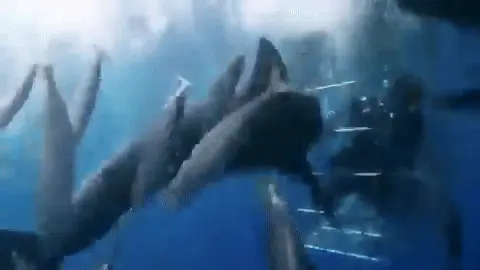Tourism
news
Watch the first documentation of sharks glowing in the dark from the "twilight zone" of the ocean depths
Three glowing sharks were first observed by researchers in the "twilight zone" of the ocean depths near the southern island of New Zealand.
Researchers claim that they use their natural glow to "disappear", evade lunatics and hunt for food
Tags
Sharks
New Zealand
Not to be missed
Monday, 08 March 2021, 23:54
Share on Facebook
Share on WhatsApp
Share on general
Share on general
Share on Twitter
Share on Email
0 comments
Upgraded Nahal Tzipori promenade
Deer in the snow in the Deer Valley Park in Jerusalem, 18.2.21 ...
Snowy Mountains National Park 19.2.21
A project to clean the house
Is this a Tasmanian wolf record?
The head of the Yeruham Council closes two years in office: Contact me from all ...
A model was photographed naked on an elephant
Fire: If there is a wave of illness following Purim, he will have to return ...
Dr. Elrai Price: We will have to close Ben Gurion Airport for at least a month ...
The new visitor center of Timna Park
Horbat Omrit
The black ninja shark glowing in the dark discovered in 2016 (YouTube)
In the video - a new and scary discovery: Meet the "ninja shark" that glows in the dark
Last weekend, documentation was first published of glowing sharks from the depths of the ocean that produce light naturally.
The researchers say they have identified three sharks that emit light in the dark: the wrinkled shark, the blackbeard and the southern thorn shark.
All three use their glow to hide from predators and hunt prey - some of which are about 1,000 meters below sea level.
The researchers spotted the sharks at Chatham Rice, off the east coast of the South Island of New Zealand, in January 2020. They all live in the "twilight" area of the ocean, where sunlight does not penetrate, at a depth of 200 to 1,000 meters below The water - so it is also very difficult to locate them.
These sharks have been observed in the past, but this was the first time marine biologists could confirm that they are indeed bioluminescent creatures (capable of producing and emitting light as a result of a chemical reaction) - similar to other sea creatures, including jellyfish and squid, which can also emit light.
Among sharks, the wrinkled shark is the largest glowing underwater creature.
It reaches a size of 180 cm and is defined by researchers as a "giant shining shark". It usually stays at a depth of about 300 meters, preys on smaller sharks, fish that swim on the ground and crabs.
More on Walla!
A rare encounter between a sea crocodile and a bull shark ended in an unusual way that left viewers in shock
To the full article
Glow-in-the-dark sharks were first documented in the depths of the ocean near New Zealand (Photo: Official Website, Jérôme Mallefet / UC Louvain)
Scary documentation of a diver fighting a hammerhead shark with a camera stick only
A new and scary discovery: Get to know the "ninja shark" that glows in the dark
Rare Documentation: Locust fish swallows a whole shark in one bite surrounded by ten hungry sharks
You can beat the pain by walking with a home-based and comfortable treatment for up to an hour a day
The researchers say the sharks' glowing stomachs may be used to help them hide from predators or other threats, using light to make them disappear.
The fact that a bright glow can create camouflage sounds paradoxical, however creatures living in the depths of the ocean are usually portrayed as a shadow against the sky.
Some species of fish utilize biological enlightenment as a counter-enlightenment, making them more difficult to see for creatures beneath them.
Since the slow-wrinkled shark has little or no predators to threaten it, they believe it uses its natural glow to illuminate the ocean floor while searching for food or disguising itself as it approaches its prey.
They wrote in the study: "Bioluminescence is often seen as a spectacular but rare event at sea, but given the vast expanses of deep sea and the presence of glowing organisms in this area, it is increasingly clear that light production at these depths must play an important role in building the Earth's largest ecosystem. our".
The study, by Jerome Malft and Laurent Duchatlet of UC Louvain and Darren Stevens of the National Institute of Water and Atmospheric Research in New Zealand, was published in Frontiers in Marine Science.
Mr Malft told New Zealand news site Stuff that 57 of the 540 known shark species may produce bioluminescent light.
To date, no one has documented bioluminescent sharks producing light in New Zealand waters, and he says many more are possible.
"They glow in the dark. They do not produce flashes. They glow for a long time," Malft said, adding that the sharks were documented quite by chance using an observational tool from the National Institute for Water and Atmospheric Research designed to measure fish stocks: "I spent 30 days on board to document. "Sharks. I felt like a kid finding gifts under a tree at Christmas."
They use their glow precisely to disguise themselves in a place where everything is dark (Photo: Official Website, Jérôme Mallefet / UC Louvain)
The glowing sharks have not revealed all of their secrets so far, including why their dorsal fin glows.
"Further research is needed to understand whether it is being used as a signal or for some other purpose," Melfat said. "There are still big question marks left."
Malft told CNN that he plans to study the dorsal fin in more detail on his future trips to the area, as well as check what the sharks are eating and whether they are being eaten on their own.
His goal, he says, is to bring as much information as possible about the depths of the sea, which remains mysterious despite the fact that it is the most common environment on Earth - to make people think more about its conservation.
He said: "I'm afraid we've made a lot of mistakes in throwing things into the sea. I'm afraid of what will happen to future generations."
"There are still big question marks left" (Photo: Official Website, Jérôme Mallefet / UC Louvain)
Giant Shark (Photo: Official Website, Jérôme Mallefet / UC Louvain)
Share on Facebook
Share on WhatsApp
Share on general
Share on general
Share on Twitter
Share on Email
0 comments















